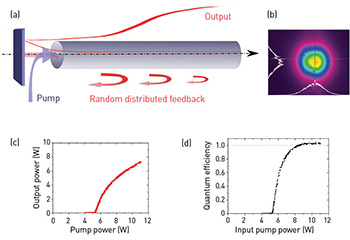 Random fiber laser with ultimate efficiency. (a) Laser design with power distribution along the fiber; (b) typical beam profile; (c) input-output curve; and (d) quantum efficiency.
Random fiber laser with ultimate efficiency. (a) Laser design with power distribution along the fiber; (b) typical beam profile; (c) input-output curve; and (d) quantum efficiency.
Raman fiber lasers provide versatile platforms to obtain high-brightness lasing over a broad wavelength range.1 For a conventional Raman fiber laser with two mirrors at each end of the fiber cavity, the reflectivity and the reflection bandwidth of the mirrors should be chosen carefully to maximize laser output. However, lasing is possible in a long fiber without any point mirrors via random distributed feedback provided by Rayleigh backscattering, which is much simpler and more stable.2
In 2014 we showed that, despite its open laser cavity design, the generation efficiency of a random Raman fiber laser can be superior to those of conventional Raman fiber lasers. To achieve this, we designed the laser with a short (≤1 km) cavity.3–5 The feedback mechanism comes from distributed Rayleigh scattering along the fiber and a fiber loop mirror formed by a 3 dB coupler, assuring intrinsically stable operation. Although the lasing threshold increased dramatically in such a short cavity, the differential generation efficiency demonstrates extraordinary behavior: just above the threshold, it amounts to several hundred percent, and more than 2 W of the lasing is generated from 0.5 W of pump excess over the lasing threshold. More important, the corresponding quantum efficiency can exceed 100 percent, due to the specific longitudinal power distribution along the cavity and lower loss for the generated wave compared to the pump wave. We define the quantum efficiency as the ratio of the Stokes photons, NSout = PSout/hνS, to the pump photons in a loss-only regime at the cavity output, NPout = PPin e–αPl/hνP.Thus, the energy transfer to a new spectral band in the short random fiber laser is accompanied with the increase of the photon number by several percent NSout / NPout = 1.03.3 With shorter fiber length, the optical conversion efficiency could approach quantum limit (defined as hνS/hνP), and the power scaling of the laser can also be dramatically increased, due to the much higher threshold of the second-order random lasing.4 An even shorter cavity of 300 m helped to achieve a 73.7 W output, with a Gaussian profile in the fundamental transverse mode.5
The random fiber laser offers greater power performance compared to conventional counterparts in a simple design without environmentally sensitive components. A random fiber laser can be scaled to the kilowatt level of output power at the designated wavelength, creating a new direction for high-power optical sources.
Researchers
Z. Wang, H. Wu, M. Fan and Y. Rao, Univ. of Elec. Sci. and Tech., China
I. Vatnik, E. Podivilov and S. Babin, Inst. of Automation & Electrometry (IA& E) SB RAS and Novosibirsk State Univ. (NSU), Russia
D. Churkin, IA&E SB RAS, NSU and Aston Univ., U.K.
H. Zhang, P. Zhou, H. Xiao and X. Wang, Nat. Univ. of Defense Tech., China
References
1. G. Agrawal. Nonlinear Fiber Optics, Acad. Press (2012).
2. S. Turitsyn et al. Phys. Rep. 542, 133 (2014).
3. I. Vatnik et al. Laser Phys. Lett. 11, 075101 (2014).
4. Z. Wang et al. IEEE J. Sel. Topics Quantum Electron. 21, 900506 (2014).
5. H. Zhang et al. Laser Phys. Lett. 11, 075104 (2014).
